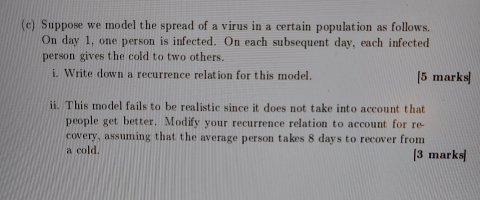You are using an out of date browser. It may not display this or other websites correctly.
You should upgrade or use an alternative browser.
You should upgrade or use an alternative browser.
Recursive Function Question PLEASE HELP
- Thread starter Tekilou
- Start date
D
Deleted member 4993
Guest
It seems you have solved the first of your problem. Please share your solution to (i).Could anyone please help on answering this question especially the second part of the question. Thanks very much I really appreciate it.View attachment 31216
Please show us what you have tried and exactly where you are stuck.
Please follow the rules of posting in this forum, as enunciated at:
Please share your work/thoughts about this problem.
BeachBanana
Senior Member
- Joined
- Nov 19, 2021
- Messages
- 2,281
[math]\text{Day 1}= 1 = 2^0\\ \text{Day 2}= 2^0\cdot2=2^1\\ \text{Day 3}= 2^1\cdot2= 2^2\\ \text{Day 4}=2^2\cdot 2=2^3\\ \vdots\\ \text{Day n-1}=?\\ \text{Day n}=?\\[/math]Do you see a pattern?Sn = 1 if n= 1
3S(n-1) if n >1
Thats my answer for part i) not sure if it's correct. But I'm confused how to do part ii) could u answer it for me. Thanks
Last edited:
Ya so what is the answer ?[math]\text{Day 1}= 1 = 2^0\\ \text{Day 2}= 2^0\cdot2=2^1\\ \text{Day 3}= 2^1\cdot2= 2^2\\ \text{Day 4}=2^2\cdot 2=2^3\\ \vdots\\ \text{Day n-1}=?\\ \text{Day n}=?\\[/math]Do you see a pattern?
D
Deleted member 4993
Guest
And where is your work using the given hint ? After all this is your assignment!!Ya so what is the answer ?
Day n = 1And where is your work using the given hint ? After all this is your assignment!!
Day n-1 = 2^n . 2
But then I'm very confused how to do part ii)?
D
Deleted member 4993
Guest
That is INCORRECT !Day n = 1
Day n-1 = 2^n . 2
But then I'm very confused how to do part ii)?
Work with response #4 - Use pencil/paper.
BeachBanana
Senior Member
- Joined
- Nov 19, 2021
- Messages
- 2,281
I was hoping you could tell us what's the pattern is. Maybe use words first, then translate that into math equations.Day n = 1
Day n-1 = 2^n . 2
But then I'm very confused how to do part ii)?
Sn = { 1 if n = 1That is INCORRECT !
Work with response #4 - Use pencil/paper.
S(n-1) + 2^S(n-1)
Okay that is correct but I am very confused how to do part ii) any hints would be much appreciated!!
Sn = { 1 if n = 1Sn = { 1 if n = 1
S(n-1) + 2^S(n-1)
Okay that is correct but I am very confused how to do part ii) any hints would be much appreciated!!
S(n-1) + 2^S(n-1) if n >1
BeachBanana
Senior Member
- Joined
- Nov 19, 2021
- Messages
- 2,281
What you presented is not an equation as there's no equal sign. I don't know why you're eager to get to part ii), when you can't get part i) right. If you can't get part i) right then you're not gonna get part ii) right. They're related. Double-check your answer, make sure it is an equation and it makes sense.Sn = { 1 if n = 1
S(n-1) + 2^S(n-1) if n >1
Suppose I want to know how many were sick on day 4 i.e. n=4, and I use what you presented I get S(4-1)+2^S(4-1)=2^2+2^(2^2). Does that make sense?
pka
Elite Member
- Joined
- Jan 29, 2005
- Messages
- 11,978
Your answer is correct, If [imath]D(1)=1[/imath] is the number infected on day one thenSn = 1 if n= 1
3S(n-1) if n >1
Thats my answer for part i) not sure if it's correct. But I'm confused how to do part ii) could u answer it for me. Thanks
for [imath]n>1[/imath] we have [imath]D(n)=2\cdot D(n-1)+D(n-1)=3\cdot D(n-1)=3^{n-1}[/imath] is the number infected on day [imath]n[/imath].
SEE HERE Scroll down to see the table of values.
Now as to the second part I don't think it can be done without better information about rates of recovery.
[imath][/imath]
BeachBanana
Senior Member
- Joined
- Nov 19, 2021
- Messages
- 2,281
Suppose n=2, D(2)=3^(2-1)=3.Your answer is correct, If [imath]D(1)=1[/imath] is the number infected on day one then
for [imath]n>1[/imath] we have [imath]D(n)=2\cdot D(n-1)+D(n-1)=3\cdot D(n-1)=3^{n-1}[/imath] is the number infected on day [imath]n[/imath].
SEE HERE Scroll down to see the table of values.
Now as to the second part I don't think it can be done without better information about rates of recovery.
[imath][/imath]
Edit: My mistake, you're right.
Thank you for your help
Your answer is correct, If [imath]D(1)=1[/imath] is the number infected on day one then
for [imath]n>1[/imath] we have [imath]D(n)=2\cdot D(n-1)+D(n-1)=3\cdot D(n-1)=3^{n-1}[/imath] is the number infected on day [imath]n[/imath].
SEE HERE Scroll down to see the table of values.
Now as to the second part I don't think it can be done without better information about rates of recovery.
[imath] [/QUOTE][/imath]
pka
Elite Member
- Joined
- Jan 29, 2005
- Messages
- 11,978
Yes it is true. Did you read the question?Suppose n=2, D(2)=3^(2-1)=3. That's not true.
On day one, one person is infected. On day two that one person infects two more people.
Now we have three people infected. On day three those three people infect six more people.
Now we have nine, [imath]3^{3-1}[/imath], people infected.
mirzatera180
New member
- Joined
- Mar 7, 2022
- Messages
- 2
Thank you for your help
Steven G
Elite Member
- Joined
- Dec 30, 2014
- Messages
- 14,603
Excuse me, but no one here will give you the answer. This is a math help math forum. Do you really think that giving you the answer would be helpful?Ya so what is the answer ?
mirzatera180
New member
- Joined
- Mar 7, 2022
- Messages
- 2
Thanks and regards for the answer..
hellodear.in
teatv apk download
hellodear.in
teatv apk download

